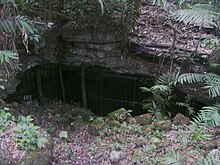Dos Pilas
It dates to the Late Classic Period, and was founded by an offshoot of the dynasty of the great city of Tikal in AD 629 in order to control trade routes in the Petexbatún region, particularly the Pasión River.[18] Itzamnaaj Kʼawiil (Ruler 2) (698–726[5]), another son of Bʼalaj Chan Kawiil, was born in AD 673, probably in Calakmul during his familyʼs exile after Dos Pilas was defeated by Tikal.His birth abroad seems to have been cause for embarrassment, with discrepancies in the calendar dates recorded on monuments likely to be the result of attempts to show that he was born in Dos Pilas itself.Twenty years before his rise to the throne he was already a prominent figure in Dos Pilas, responsible for the capture of the lord of Tikal in AD 705 and being closely involved in rituals performed by the previous king.[19] "Master of Sun Jaguar" died in May 741, his death is recorded on Stela 1 at his twin capital of Aguateca where it is believed that he was buried, although his tomb has not yet been found.[20] Kʼawiil Chan Kʼinich (Ruler 4) (741–761+[5]) was installed on the throne of Dos Pilas in June of AD 741, 26 days after the death of "Master of Sun Jaguar".[21] The early history of the Dos Pilas site is unclear; there are traces of an earlier indigenous dynasty predating the arrival of Bʼalaj Chan Kʼawiil from Tikal.In AD 629, the Tikal king Kʼinich Muwaan Jol II installed his son Balaj Chan K’awiil, aged four, as ruler of Dos Pilas.[23] In an extraordinary act of treachery for someone claiming to be of the Tikal royal family, he thereafter served as a loyal ally of Calakmul, Tikalʼs sworn enemy.[24] King Nuun Ujol Chaak of Tikal attacked and captured Dos Pilas in AD 672, driving Bʼalaj Chan Kʼawiil into a five-year exile, probably in Calakmul.[25] This exile was only ended in AD 677, on the same day that Calakmul celebrated a success over Tikal, revealing Bʼalaj Chan Kʼawiilʼs obvious dependency on his foreign overlord.For Dos Pilas, this battle represented the consolidation of its kingdom and the failure of Tikal to crush its splinter state before it gained a foothold.[29] Around this time Balaj Chan Kʼawiil died and was succeeded by one of his sons, Itzamnaaj Balam, although the exact year is not clear from the hieroglyphic texts.In AD 735 the Lord of Dos Pilas (Ruler 3, "Master of Sun Jaguar") attacked the city, capturing Yichʼaak Bʼalam, its king.[5][31] At about this time, the nearby site at Aguateca became a twin capital of the Dos Pilas kingdom, with victory monuments being erected simultaneously in both cities.Two years later, in AD 745, he went to war against the distant cities of Yaxchilán, on the Usumacinta River, and Motul de San José on Lake Petén Itzá.[6] The entire Petexbatún region was engulfed by warfare in the late 8th century AD until almost all the settlements of the former Dos Pilas kingdom were abandoned.[35] A small group of refugees occupied Dos Pilas after its abandonment, throwing up hastily built defensive walls constructed from stone stripped from the deserted temples and palaces.[33] The collapse of the Dos Pilas state seems to have benefited other sites in the region, such as Itzan, Cancuén and Machaquila, which all demonstrate renewed strength coincident with the fall of the city.The project continued through to 1994, supported by the National Geographic Society, the Instituto de Antropología e Historia (IDAEH - Institute of Anthropology and History), Vanderbilt University and several other organisations.[42] The site is laid out around three monumental complexes aligned upon an east-west axis, in a form that is reminiscent of the Preclassic layouts at El Mirador and Nakbe in the far north of Petén.[50] El Duende is the largest pyramid in the city, built by enlarging and terracing a natural hill some way from the site core, giving the impression of a single massive structure.The fact that the El Duende group were originally named after this subterranean water source demonstrates how important this cave was to the ancient inhabitants of Dos Pilas.



Bʼalaj Chan KʼawiilItzamnaaj KʼawiilUchaʼan Kʼin BʼalamKʼawiil Chan KʼinichLate ClassicPre-ColumbianMaya civilizationdepartmentPeténGuatemalaLate Classic Periodtrade routesPetexbatúnPasión RivervassalCalakmulArroyo de PiedraTamarinditoAguatecaPetexbatún LakeGuatemalan SpanishPetén BasinPasiónSalinasSayaxchéUsumacinta RiverforestedList of kings of Dos PilasWak Chanil AjawNaranjoItzamnaaj BʼalamCancuénEarly ClassicYuknoom Chʼeen IINuun Ujol ChaakLady Six SkyPeopleSocietyLanguagesWritingReligionMythologySacrificeCitiesArchitectureAstronomyCalendarStelaeTextilesMedicineCuisineWarfareHistoryPreclassic MayaClassic Maya collapseSpanish conquest of the MayaYucatánChiapasSeibalYichʼaak BʼalamYaxchilánMotul de San JoséLake Petén ItzácollapseMachaquilaArthur DemarestVanderbilt UniversityUniversity of San Carlos of GuatemalaNational Geographic SocietyInstituto de Antropología e HistoriaChʼolan Maya languageEl Miradorball courtPreclassicList of Mesoamerican pyramidsAmerican Anthropological AssociationCoe, Michael D.Demarest, Arthur A.Weidenfeld & NicolsonFoundation for the Advancement of Mesoamerican Studies, Inc. (FAMSI)Houston, Stephen D.Peter MathewsMartin, SimonNikolai GrubeMathews, PeterGordon R. WilleyMiller, Mary EllenArthur A. DemarestSchele, LindaWilliam Morrow and CompanySharer, Robert J.Instituto de Antropología e Historia de GuatemalaMaya sitesBelizeActun Tunichil MuknalAltun HaBaking PotBarton Creek CaveCahal PechCaracolCerrosChaa CreekCuelloEl PilarKaʼKabishKʼaxobLa MilpaLamanaiLouisvilleLower DoverLubaantunMarco GonzalezMinanhaNim Li PunitNohmulNohoch CheʼenPacbitunPusilhaSan EstevanSanta RitaUxbenkaXnahebXunantunichAltar de SacrificiosBalbertaBejucal
